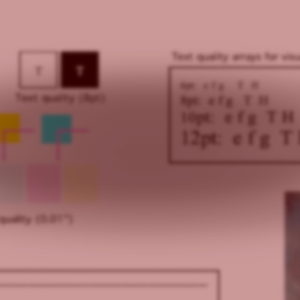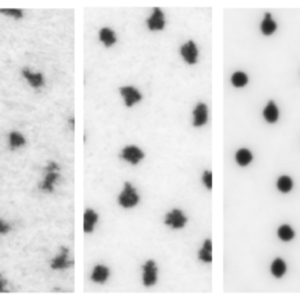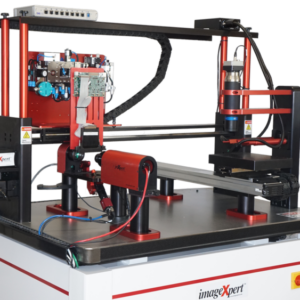The Pros Share How to Succeed With Inkjet Additives and Pretreatments
Last Updated on June 25, 2024 by ImageXpert Team
For this post, we sat down with Vedran Durasevic, Head of Inkjet Inks at EVONIK CAD to learn from his team’s knowledge of the raw materials working behind-the-scenes to make inkjet successful. He graciously helped to put together this article to share this information with the inkjet community. Enjoy!
The inspiration for this article came from a recent collaboration between ImageXpert and EVONIK Coating Additives to design a high-tech print station system that could watch inkjet drops spreading and drying moments after impact with the substrate. Evonik Coating Additives specializes in supplying the printing ink market with a wide portfolio of raw materials such as dispersants, co-dispersants, surfactants, co-binders, binders, silicas and their dispersions suitable for the most demanding of application methods such as inkjet. With so many additives to choose from, selecting the right additive the first time is vital to the success of many projects. In order to supply as specific and accurate product recommendations as possible, EVONIK CAD wanted the ability to test additives and ink-substrate interaction under real application conditions in their jetting lab. With this system, developers could watch the effects of different ink formulation choices, as well as substrate pretreatments or coatings on the printed dots in real time, to learn more about the underlying process and provide superior support for their customers in their development process. In this article, Evonik Coating Additives shares some of their extensive knowledge of inks, raw materials, and pretreatments, and some of the images and data captured using the new system.
What Are Pretreatments Used For?
In order to understand the value of pretreating a surface, the first thing to remember is that the high print quality required for images viewed from a short distance calls for inkjet inks that are designed to be extremely fluid, with low viscosity and surface tension. This fluidity is what allows them to be squeezed through tiny nozzles in a controllable way during the jetting process, and is extremely advantageous during the first half of the printing process. However, this fluidity makes the second half of the process, the impact and drying on the substrate, all the more challenging. The ink has the potential to move, change shape, and absorb into the substrate in all sorts of uncontrollable ways thanks to its properties. Controlling the behavior of the ink once it hits the surface is the primary duty of a pretreatment, which can be chemical, thermal, electrical, and more.
Challenges unique to the substrate used for each application determine what type of pretreatment is called for, but there are common dynamic principals that apply to all substrates. One important principal is the wettability of the ink and substrate combination. Wettability is the degree to which the ink will spread out on the surface of the substrate; if you want the ink to adhere to the substrate, it needs to spread out very well and maximize the surface contact. The relationship between the surface energy of the substrate and the surface tension of the ink plays a big role in the wettability. The higher the surface energy of the substrate compared to the ink, the better the ink will spread. There is a surface creation event taking place over the time that the droplet has been fired from the nozzle, reaches the substrate, and spreads until it is either partially or fully cured. It is within that window that the surface tension of the ink needs to be below the surface free energy of the substrate it needs to spread over.
Handling Extremely Absorbent Substrates
For example, textile substrates are extremely absorbent and will soak up the ink. This has negative impacts on the color intensity, image quality, feel, and cost of the textiles (all that ink is expensive). The surface tension of the ink usually only has to be reduced to about 30mN/m to wet the textile, which is not challenging. However, the surface tension also has to be tightly controlled over time, relative to the kinetics of the drop spread, so that it does not penetrate too deep into the structure of the textile and get lost. This requirement is met using what the industry refers to as dynamic surface tension reduction additives such as linear or branched alcohol polyethers, or acetylenic diol ethoxylate based wetting additives, which are now quite well established in the market.
In order to help control this process, a chemical pretreatment is used to act as a buffer between the ink and the absorbent substrate. The pretreatment acts as a bonding agent, so once the ink hits the material, it stays put without color bleed or other negative effects on the image. For instance, pre-treating textiles with silica-based primers can improve the color intensity, print quality, and fastness properties of both dye and pigment-based inks. These improvements arise from either a pigment particle being locked in place by the defined porous structure of the silica or from the anion chromophore of the dye molecule being electrostatically bonded to cationic silica containing primer.
Handling Extremely Unabsorbent Substrates
EVONIK CAD also specializes in substrates on the other end of the spectrum: plastics and polymers that are hydrophobic and naturally not very wettable. Polymeric films used in the packaging industry represent a greater challenge than textiles respectively, as they require a pre-treatment process aimed at increasing the surface energy of the substrate by increasing the number of oxygen rich functional groups at the surface. Corona or plasma treatments are commonly used for this purpose. After the pre-treatment, substrates like polypropylene or polyester will be receptive to inks with a static surface tension in the range of 20 mN/m.
It is important to remember that it is not only the sheer ‘number’ that counts here. Surface free energy is a total of polar and dispersive parts, where in many cases dispersive parts prevail over polar even after the pre-treatment. This is compensated by using a surface-active additive from a group of organo-modified siloxanes as they represent a much better fit for polyolefine substrates containing relatively high portion of the dispersive part of the surface free energy. Short backbone siloxanes are preferred here, as they will most rapidly migrate from the bulk of the fluid (droplet) to the surface-air interface. Careful selection of a surface-active agent for polymeric substrates will also minimize interfacial tension of the liquid-solid interface thus supporting adhesion of the ink to the substrate.
Pretreatments: Before and After
As you can see, it is quite a challenge to get the amount of spreading just right: too little and the ink won’t adhere to the substrate, too much and the image becomes blurry as the dots all bleed together. But how much is the right amount? Enter the JetXpert Print Station system for watching ink spread and dry.
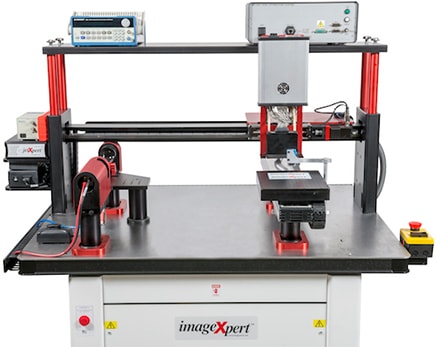
JetXpert Print Station
Ultimate R&D productivity with all-in-one drop analysis, sample printing, and print quality analysis.
Learn MoreHere is an example of what happens when you print onto a polyethylene film that is untreated and not well matched to the ink. In this case, a high substrate speed was used, with a waveform that produced ligaments / lines, which better demonstrates the drop-substrate interaction, The surface free energy of the substrate is too low, especially the polar parts, which means that the ink won’t grip the surface.
Before
Notice that the ink does not adhere to the surface at all and beads up. Imagine trying to print an image when this is happening to the ink on the surface. Compare this to a pretreated polyethylene film.
After
Notice how the ink does a much better job of staying in place?
Join Our Mailing List
Studying the Speed of Wetting
Another factor to think about is the duration over which this movement is occurring so that you can time your curing / drying properly. For surfaces that are not very wettable, the ink needs time to spread out and increase the surface contact before it is cured, otherwise it may not have a chance to adhere well to the surface and come off. But waiting too long means that the ink dots might start to coalesce together and compromise the image. Or even worse, your printer is going slower than it could be! Here is an example of ink on the surface over a timeframe of 250ms to 5 seconds after it is jetted.
As you can see, the majority of the drop spreading seems to occur very early, which is the sign of a good pretreatment for this application. We want the ink to wet the substrate fast so we can immediately keep it moving to the next phase of the printing process without any delay. The purpose of this particular test print wasn’t to optimize dot quality, but to investigate drop spreading. However, ImageXpert systems have the capability to automatically analyze both dot quality and changes in ink coverage over time. Example images of this kind of analysis are shown below, along with a chart showing the measured change in coverage over time.
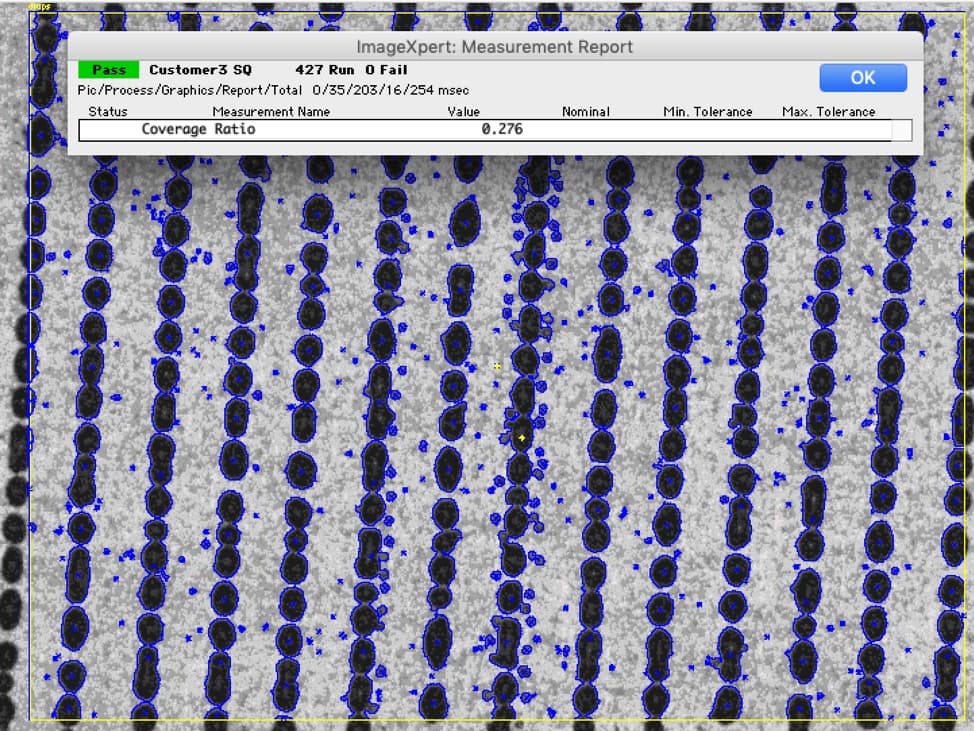
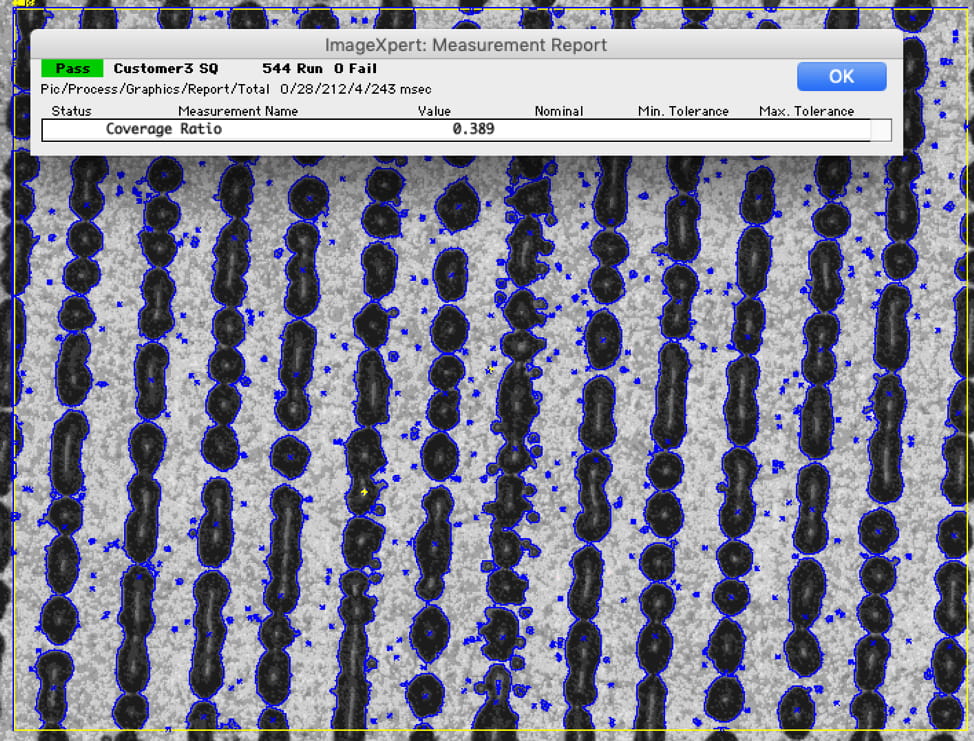
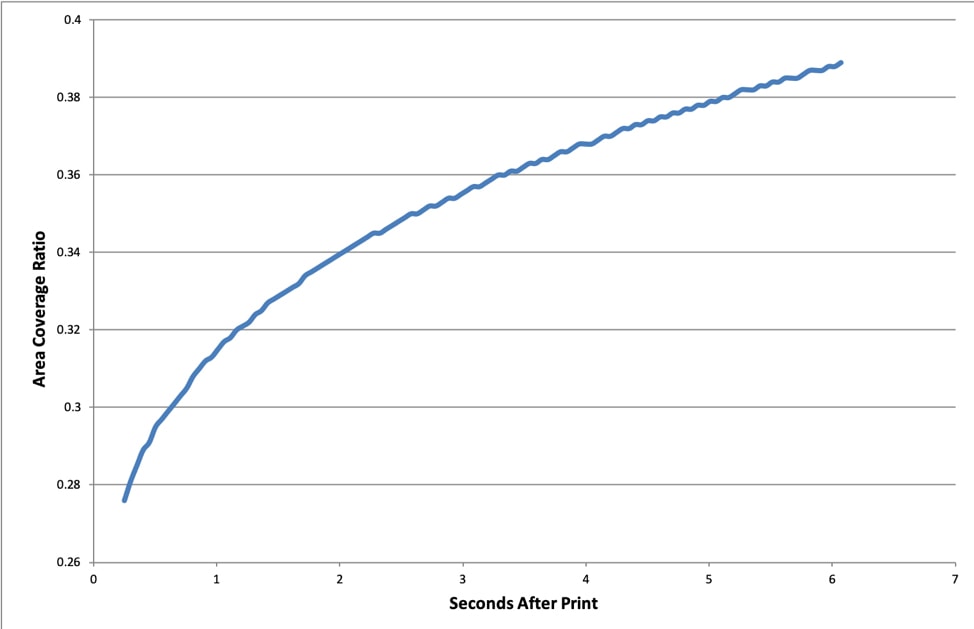
Of course, because we care very much about Dot Quality we are also looking for the dots to maintain their positions and shapes throughout the spreading process.
Expanding Testing Capabilities
EVONIK CAD plans to use this system to keep them at the forefront of the market. With the ability to deposit up to four colors with full or partial curing, they can study the interaction of different colors at various interfaces such as substrate-droplet and droplet-droplet. They will investigate the potential of imparting fastness properties to inherently low viscosity fluids to address the need for functional inks in industrial printing, which may require studying new materials, combining several ink types, and potentially even combining application technologies. The flexibility of the system, which also includes dropwatching capabilities, will enable them to map out an entire additive portfolio by ability to wet out specific substrates, while potentially uncovering additive design niches, and hopefully revealing new platforms for building the additives of the future.
Final Word
As more industrial printing applications turn to inkjet, the demand to close the printing speed gap on analog printing processes will be the determining factor for the adoption of inkjet-based applications. Other predominant factors will be the robustness of the entire printing process, functionality of the dried ink with respect to fastness properties, price per printed unit, and the potential of the technology to evolve in the future. The raw materials acting behind the scenes are a major driving force for improving the speed, fastness, functionality, and future of the inkjet market.
We want to truly thank Evonik Coating Additives for sharing their knowledge with us to help expand the capabilities of the industry. With their presence and focus on inkjet, Evonik Coating Additives belongs to a community of inkjet technology enablers: a group of similar companies and industry frontrunner professionals making sure inkjet is a sound technology thrives in the future. They are a single source for a wide breadth of raw materials, detailed technical information, advice and support: a true invitation for the industry to engage with them and to jointly develop new technologies. You can learn more about Evonik Coating Additives here. For questions, please do not hesitate to write to additives4inks@evonik.com

